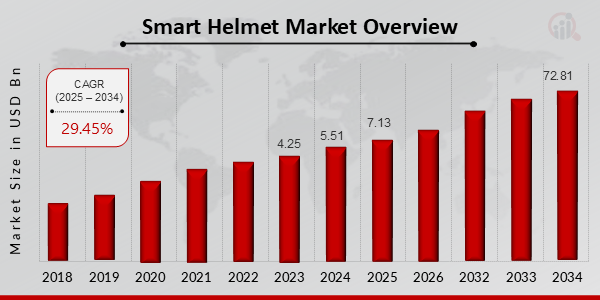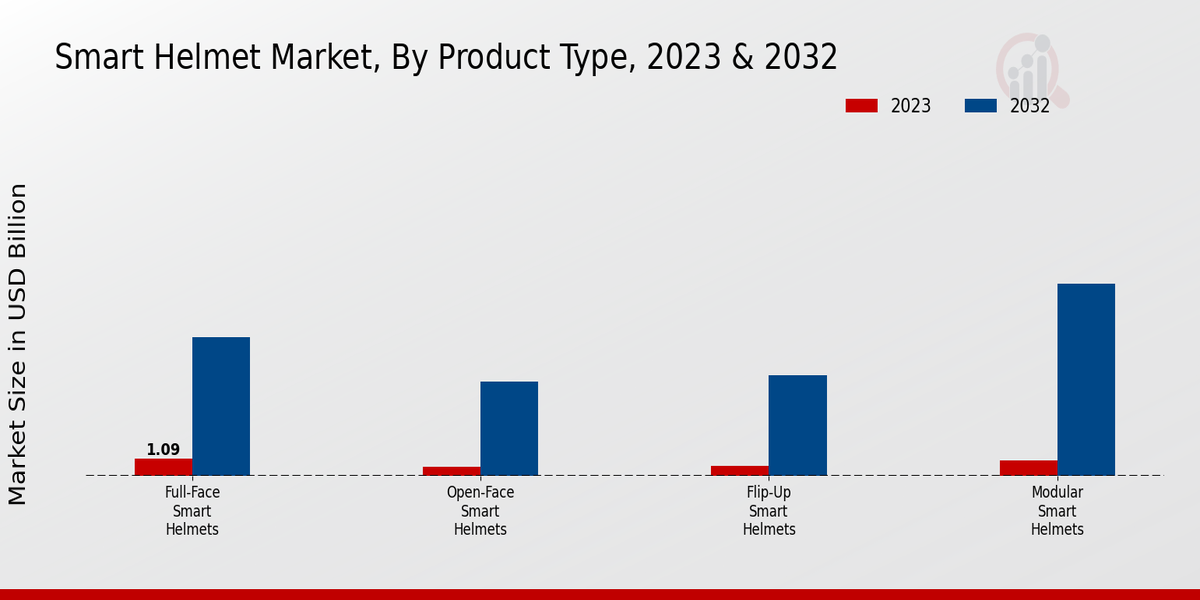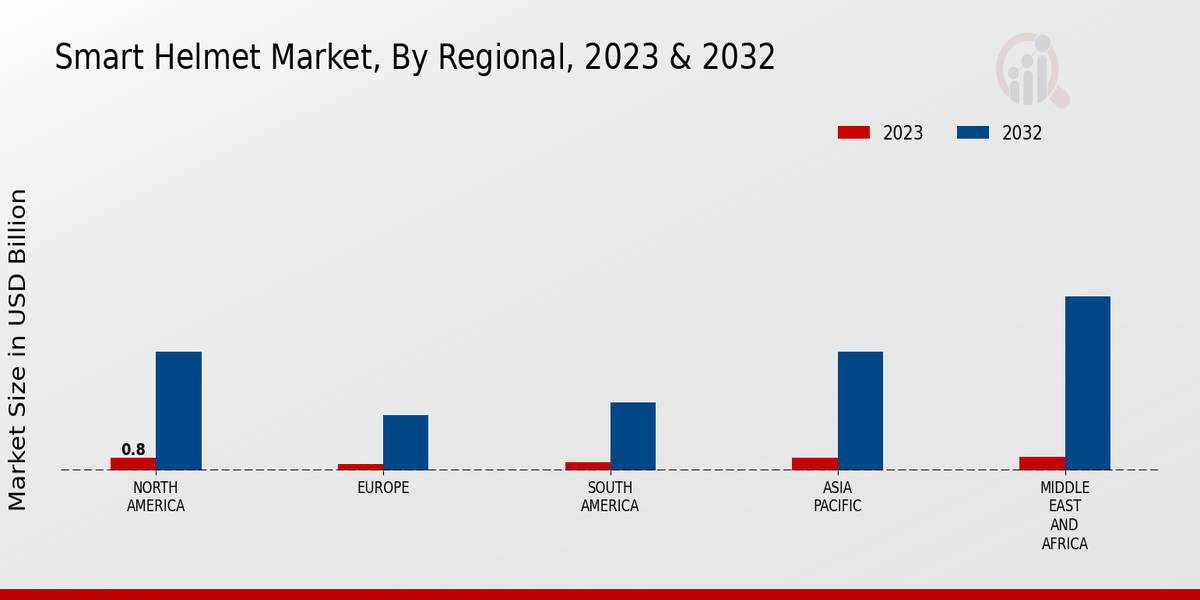Smart Helmet Market Overview
Smart Helmet Market is projected to grow from USD 7.13 Billion in 2025 to USD 72.81 Billion by 2034, exhibiting a compound annual growth rate (CAGR) of 29.45% during the forecast period (2025 - 2034). Additionally, the market size for Smart Helmet Market was valued at USD 5.51 billion in 2024.
Key Smart Helmet Market Trends Highlighted
The growth of the smart helmet market is being propelled by rising urban mobility and the love for two-wheelers in urban areas. Demand for smart helmets that include things like navigation systems, communication capabilities, and safety features is on the rise, and many people are becoming more concerned about how they commute.
Moreover, increased awareness about road safety, as well as government regulations that encourage the use of protective gear, acts as a driving factor in the market. Helmet manufacturers have been able to incorporate multiple advanced functions such as Bluetooth, GPS and sensors, which enhance security as well as ease of use due to technological advances.
The advent of electric two-wheelers and the demand for specialized helmets designed particularly for these vehicles create new avenues in the smart helmet market. Furthermore, the integration of artificial intelligence together with IoT capabilities into smart helmets will be a major drivers for future growth.
Figure 1: Smart Helmet Market Size, 2025-2034 (USD Billion)

Source: Primary Research, Secondary Research, Market Research Future Database and Analyst Review
Smart Helmet Market Drivers
Rising Popularity of Adventure Sports and Activities
The growing popularity of adventure sports and activities such as rock climbing, mountain biking, and skiing has significantly contributed to the demand for smart helmets. These helmets are designed with advanced features to enhance safety and protection for participants in these high-risk activities.
The integration of sensors, cameras, and communication systems in smart helmets allows for real-time monitoring of the user's condition, accident detection, and emergency response, providing peace of mind and reducing the risk of severe injuries or fatalities.The increasing number of adventure enthusiasts and the desire for enhanced safety measures are key drivers for the growth of the smart helmet market. As adventure sports and activities continue to gain traction, the demand for smart helmets is expected to rise accordingly, driving market expansion.
Technological Advancements and Innovation
The rapid advancements in technology have played a crucial role in shaping the Smart Helmet Market Industry. The advent of new technologies, such as artificial intelligence (AI), computer vision, and the Internet of Things (IoT), has enabled the integration of sophisticated features into smart helmets. These features include advanced sensors for monitoring vital signs, GPS tracking for navigation and location sharing, and Bluetooth connectivity for hands-free communication.The continuous innovation and development of new technologies are expected to further enhance the capabilities of smart helmets, making them indispensable for safety and protection in various applications.
Increasing Awareness of Safety and Regulation
Growing awareness about safety and the implementation of stricter regulations regarding helmet use has contributed to the demand for smart helmets. Governments and organizations worldwide are recognizing the importance of protecting individuals engaging in high-risk activities. As a result, regulations are being enforced to mandate the use of helmets in certain sports and workplaces. This has led to an increase in the adoption of smart helmets, which offer superior protection and enhanced safety features compared to traditional helmets.
Smart Helmet Market Segment Insights
Smart Helmet Market Product Type Insights
The Smart Helmet Market segmentation by product type includes Full-Face Smart Helmets, Open-Face Smart Helmets, Flip-Up Smart Helmets, and Modular Smart Helmets. Among these, Full-Face Smart Helmets held the largest market share in 2023, and it is expected to continue its dominance during the forecast period. The high demand for Full-Face Smart Helmets can be attributed to their ability to provide comprehensive protection to the rider's head and face, making them ideal for high-speed riding and competitive sports.
The increasing popularity of adventure sports and the growing awareness about safety regulations are driving the growth of the Full-Face Smart Helmets segment.
Open-Face Smart Helmets are expected to witness a steady growth rate during the forecast period. These helmets offer a balance between protection and ventilation, making them suitable for urban commuting and casual riding. Flip-Up Smart Helmets, which combine the features of Full-Face and Open-Face Smart Helmets, are also gaining traction in the market. Modular Smart Helmets, which offer the flexibility to be converted from a Full-Face to an Open-Face helmet, are expected to have a niche market share during the forecast period.
Overall, the Smart Helmet Market is expected to witness significant growth in the coming years, driven by factors such as increasing safety concerns, advancements in technology, and rising disposable income levels.
Figure 2 Smart Helmet Market Type Insights, 2023-2032 (USD Billion)

Source: Primary Research, Secondary Research, Market Research Future Database and Analyst Review
Smart Helmet Market Application Insights
The Smart Helmet Market segmentation by Application is Motorcycle Riding, Cycling, Construction, Industrial, Military and Law Enforcement. The Motorcycle Riding segment held the largest market share in 2023, accounting for over 50% of the Smart Helmet Market revenue. The growth of this segment is attributed to the increasing popularity of motorcycles and the rising demand for safety gear among riders. The Cycling segment is also expected to witness significant growth in the coming years, owing to the growing popularity of cycling as a recreational and fitness activity.
The Construction, Industrial, Military and Law Enforcement segments are also expected to contribute to the growth of the Smart Helmet Market, driven by the increasing demand for protective gear in these industries. Overall, the Smart Helmet Market is expected to witness significant growth in the coming years, driven by the growing awareness of safety and the increasing adoption of smart technologies in various industries.
Smart Helmet Market Connectivity Insights
Connectivity plays a pivotal role in the smart helmet market. Bluetooth, Wi-Fi, Cellular, and GPS are the key connectivity technologies adopted by smart helmet manufacturers. Bluetooth is the most widely used technology, enabling wireless communication between the helmet and other devices such as smartphones, allowing riders to control music, make calls, and access navigation apps. Wi-Fi connectivity allows helmets to connect to the internet, enabling features like firmware updates, remote diagnostics, and cloud-based data storage.
Cellular connectivity provides real-time data transmission, enabling advanced applications such as crash detection, emergency alerts, and remote tracking.GPS technology enables location tracking and navigation, aiding riders in unfamiliar areas or during long-distance journeys. The Smart Helmet Market revenue for the Connectivity segment is projected to grow significantly in the coming years, driven by the increasing demand for advanced connectivity features and the growing adoption of smart helmets across various applications.
Smart Helmet Market Features Insights
The Smart Helmet Market is segmented by Features into Integrated Communication Systems, Heads-Up Displays, Navigation Systems, Collision Warning Systems, Environmental Sensors, and Gesture Control. Among these, Integrated Communication Systems held the largest market share in 2023, and it is expected to continue its dominance throughout the forecast period. The growing adoption of smart helmets in various industries, such as construction, mining, and manufacturing, is driving the demand for integrated communication systems. These systems allow users to communicate with each other and with remote teams, improving coordination and safety.
Heads-Up Displays (HUDs) are also gaining popularity, as they provide riders with critical information without distracting them from the road. Navigation Systems are another important feature, as they help riders find their way in unfamiliar areas. Collision Warning Systems (CWS) are becoming increasingly common, as they can help prevent accidents by alerting riders to potential hazards. Environmental Sensors are also becoming more popular, as they can provide riders with information about the air quality and temperature. Gesture Control is another emerging feature that allows riders to control their helmet's functions with simple hand gestures.
Smart Helmet Market Price Range Insights
Segmentation by price range provides valuable insights into the Smart Helmet Market. In 2023, the economy segment accounted for the largest revenue share of 45.6%. Mid-range segment revenue is expected to increase from USD 620 million in 2023 to USD 4.32 billion by 2032. The premium segment is projected to grow at a CAGR of 31.2% from 2023 to 2032, with a market valuation of USD 7.68 billion by 2032. This growth is attributed to increasing demand for advanced features, improved safety standards, and enhanced user experience in smart helmets.
Smart Helmet Market Regional Insights
The Smart Helmet Market is segmented into North America, Europe, APAC, South America, and MEA. Among these regions, North America is expected to hold the largest market share in 2023, owing to the presence of major players and early adoption of advanced technologies. Europe is expected to follow North America, driven by growing awareness about safety regulations and increasing demand for smart helmets in various industries. APAC is projected to witness the highest growth rate during the forecast period due to rapid urbanization, rising disposable income, and increasing adoption of smart devices.
South America and MEA are expected to contribute a significant share to the Smart Helmet Market, which is driven by growing infrastructure development and increasing demand for safety gear in these regions.
Figure 3 Smart Helmet Market Regional Insights, 2023-2032 (USD Billion)

Source: Primary Research, Secondary Research, Market Research Future Database and Analyst Review
Smart Helmet Market Key Players And Competitive Insights
Major players in the Smart Helmet Market are continually striving to develop innovative products and strengthen their market positions. They engage in strategic partnerships, acquisitions, and collaborations to expand their product portfolios, enhance their technological capabilities, and enter new markets. Leading Smart Helmet Market players are investing in research and development to advance their offerings, incorporating advanced technologies such as augmented reality, artificial intelligence, and connectivity features. Ongoing Smart Helmet Market industry developments include the integration of sensors, cameras, and communication systems to enhance safety and functionality.
A prominent competitor in the Smart Helmet Market is Sena Technologies, Inc., which is recognized for its innovative helmet communication solutions. The company focuses on developing high-quality products that seamlessly integrate with Bluetooth devices, providing riders with hands-free communication, music streaming, GPS navigation, and more. Sena has a strong global presence and is known for its commitment to customer satisfaction and technical support.
Another leading competitor in the Smart Helmet Market is Skully Systems Inc., renowned for its advanced augmented reality smart helmet. The company's helmet is equipped with a high-resolution display that projects essential information into the rider's field of view, enhancing safety and situational awareness. Skully Systems has received significant industry recognition and funding, demonstrating its strong position in the development of the Smart Helmet Market.
Key Companies in the Smart Helmet Market Include
- Interphone Communications
Smart Helmet Market Industry Developments
The Smart Helmet Market is projected to reach USD 33.52 billion by 2032, exhibiting a CAGR of 29.45% from 2024 to 2032. The increasing adoption of smart helmets by motorcyclists for enhanced safety and convenience is driving market growth. Technological advancements, such as the integration of sensors, communication systems, and augmented reality displays, are further fueling market expansion. Key players in the market include Sena Technologies, Inc., Cardo Systems, Inc., and Skully Technologies, Inc.
Recent developments include the launch of the Sena 50S, a Bluetooth-enabled smart helmet with a built-in camera, and the introduction of the Skully AR-1, a helmet with an integrated augmented reality display. These innovations are expected to drive market growth in the coming years.
Smart Helmet Market Segmentation Insights
-
Smart Helmet Market Product Type Outlook
-
Smart Helmet Market Application Outlook
- Military and Law Enforcement
-
Smart Helmet Market Connectivity Outlook
-
Smart Helmet Market Features Outlook
- Integrated Communication Systems
- Collision Warning Systems
-
Smart Helmet Market Price Range Outlook
-
Smart Helmet Market Regional Outlook
|
Report Attribute/Metric
|
Details
|
|
Market Size 2024
|
5.51 (USD Billion)
|
|
Market Size 2025
|
7.13 (USD Billion)
|
|
Market Size 2034
|
72.81 (USD Billion)
|
|
Compound Annual Growth Rate (CAGR)
|
29.45% (2025 - 2034)
|
|
Report Coverage
|
Revenue Forecast, Competitive Landscape, Growth Factors, and Trends
|
|
Base Year
|
2024
|
|
Market Forecast Period
|
2025 - 2034
|
|
Historical Data
|
2019 - 2023
|
|
Market Forecast Units
|
USD Billion
|
|
Key Companies Profiled
|
Caberg, Interphone Communications, Schuberth, HB Helmet, LS2 Helmets, Cardo, Origine Helmets, Helite Helmets, Lazer Helmets, Scorpion Sports, TT, Torc Technologies, Sena Technologies, 100%, LIVALL Riding
|
|
Segments Covered
|
Product Type, Application, Connectivity, Features, Price Range, Regional
|
|
Key Market Opportunities
|
AIpowered features for enhanced safety Integration with IoT platforms for data analytics Growing adoption in the construction and industrial sectors Surge in demand for smart helmets in developing economies Increasing government initiatives promoting helmet safety
|
|
Key Market Dynamics
|
Increasing adoption of connected devices Growing focus on safety and security Technological advancements Rising disposable income Government initiatives
|
|
Countries Covered
|
North America, Europe, APAC, South America, MEA
|
Frequently Asked Questions (FAQ):
The Smart Helmet Market size was valued at USD 5.51 billion in 2024 and is projected to reach USDc72.81 billion by 2034, exhibiting a CAGR of 29.45% during the forecast period.
North America is expected to dominate the Smart Helmet Market throughout the forecast period. The region's dominance can be attributed to the presence of key players, high disposable income, and increasing adoption of advanced technologies.
Smart helmets find applications in various industries, including construction, mining, manufacturing, and transportation. They offer enhanced safety features, communication capabilities, and data collection functionalities, making them valuable tools for workers in hazardous environments.
The Smart Helmet Market is highly competitive, with several established players and emerging startups. Some of the key competitors include 3M, Honeywell, Sena Technologies, Inc., and Skully Helmets, Inc.
The growth of the Smart Helmet Market is primarily driven by increasing safety concerns in hazardous work environments, technological advancements, and rising demand for hands-free communication and data collection solutions.
The Smart Helmet Market faces challenges such as high costs, limited battery life, and concerns over data privacy and security. Additionally, the lack of standardized regulations and certification processes can hinder market growth.
Emerging trends in the Smart Helmet Market include the integration of artificial intelligence (AI), augmented reality (AR), and the Internet of Things (IoT). These advancements enhance the functionality and safety features of smart helmets, leading to increased adoption.
The COVID-19 pandemic had a moderate impact on the Smart Helmet Market. While there was a temporary decline in demand due to lockdowns and supply chain disruptions, the market rebounded as safety concerns and the need for remote collaboration increased.
The Smart Helmet Market is expected to witness significant growth in the coming years, driven by increasing adoption in various industries, technological advancements, and government initiatives promoting workplace safety.
Key opportunities for players in the Smart Helmet Market include expanding into emerging markets, developing innovative products with advanced features, and forming strategic partnerships to enhance market reach and capabilities.

















